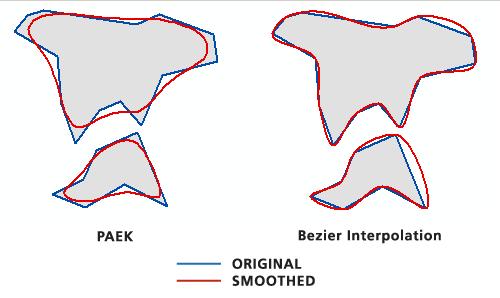Smooths sharp angles in polygon outlines to improve aesthetic or cartographic quality.
- There are two smoothing methods to choose from:
- The PAEK (Polynomial Approximation with Exponential Kernel) method smooths polygons based on a smoothing tolerance. Each smoothed polygon may have more vertices than its source polygon. The Smoothing Tolerance parameter controls the length of a "moving" path used in calculating the new vertices. The shorter the length the more detail that will be preserved and the longer the processing time.
- The Bezier interpolation method (BEZIER_INTERPOLATION in Python) smooths polygons without using a tolerance by creating Bezier curves to match the input lines. If the output is a shapefile, the Bezier curves will be approximated, since true Bezier curves cannot be stored in shapefiles.
- Smoothing may introduce topological errors such as polygon outline crossings. Use the Flag errors option (FLAG_ERRORS in Python) in the Handle Topological Errors parameter to identify these errors. Two fields will be added—InPoly_FID and SmoPlyFlag—to contain input feature IDs and topological errors. Values of 1 in the SmoPlyFlag field indicate a topology error; 0 (zero) indicates no error. The InPoly_FID field links the output polygons to their input polygons. The Flag errors option cannot be used within an edit session.

Viz také:http://desktop.arcgis.com/en/arcmap/10.3/tools/cartography-toolbox/smooth-polygon.htm
23.12.2016 11:21:23



